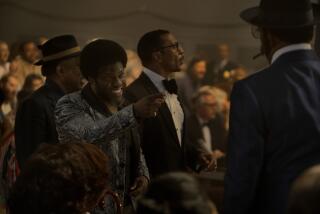Gee, Officer Krupke, Can’t You Intervene?
- Share via
Who knows? Maybe being in a street gang in late-1950s New York really was like being trapped in a bad movie. All that jazz about defending turf, avenging real and imagined slights, and adopting a thugs’ code of honor could have been sculpted from cheese recycled from B westerns, battle epics and swashbucklers playing at the corner movie house.
Given such dime-store sensibilities to work with, it’s somewhat surprising that some very good films have been made about 1950s New York street gangs, notably “West Side Story” (1961), “The Lords of Flatbush” (1974), and your correspondent’s favorite, “The Wanderers” (1979). With gems like these as inspiration, it’s both inexplicable and inexcusable that a boneheaded operation like “Deuces Wild” could have been allowed to exist.
Let’s guess why. Someone probably figured that now would be a good time to return to those thrilling days of yesteryear, replacing the misty haze of lyricism and nostalgia with a blunt-edged hyperrealism. Which sort of makes sense when you consider that the target audience for blood-and-guts movies these days is way too young to get the warm fuzzies from listening to doo-wop and remembering when Duke Snider played for the Dodgers.
Director Scott Kalvert (“The Basketball Diaries”), working with a script drawn from the boyhood memories of co-writer and co-producer Paul Kimatian, wields this down-and-dirty impulse like one of the lead pipes used in the gang fights. Those fight scenes, by the way, are orchestrated with a mix of operatic brutality and high-tech razzle-dazzle that would appear to mitigate any claims to realism. (Still, the fights are staged better than scenes requiring personal interaction.)
In no other way is “Deuces Wild” a groundbreaker, except in the manner in which it grinds the old formula trappings into asbestos. There’s the kindly neighborhood priest urging his volatile young flock to play nice. (Once you get over the giddy shock of seeing Vincent Pastore from “The Sopranos” with a priest’s collar as Father Aldo, you notice the role isn’t a bad fit.) There are the grandly dysfunctional neighborhood moms, wailing and moaning while their kids break things over each other’s heads. There’s even forbidden romance between a member of one gang and a sister of a rival gang member.
The smoldering core of this messiness is Leon (Stephen Dorff), who, if this were set in 1998 instead of 1958, would be called a multi-tasker. He’s the leader of the Deuces, a teen gang patrolling a stretch of Brooklyn’s Sunset Park neighborhood with the tacit approval of local mobster Fritzy (Matt Dillon). His short-fused brother, Bobby (Brad Renfro, once again showing why he’s so perfect at playing knuckleheads), makes goo-goo eyes at Annie (Fairuza Balk), who is sister to a member of the rival Vipers gang. The head Viper is a drug-dealing angel of death named--can’t you guess?--Marco (Norman Reedus), who wants Leon dead. And Leon wants Marco dead because ...
Skip it. Just fill in the blanks and you too can brew the same bland, goopy mixture, right down to such clunker lines as “There is a Santa Claus, Ma. He just doesn’t come to Brooklyn anymore.” Or, I guess, to the multiplexes.
*
MPAA rating: R, for strong violence, language, some drug content and brief sexuality. Times guidelines: Gratuitous violence is not suitable for children under 17.
Gene Seymour is a film critic for Newsday, a Tribune company.
‘Deuces Wild’
Stephen Dorff...Leon
Brad Renfro...Bobby
Fairuza Balk...Annie
Norman Reedus...Marco
Frankie Muniz...Scooch
Matt Dillon...Fritzy
A Cinerenta-Cinewild and Unity Productions presentation, in association with Presto Productions and the Antonia Company, released by United Artists. Director Scott Kalvert. Producers Michael Cerenzie, Willi Baer, Fred Caruso, Paul Kimatian. Executive producers Mario Ohoven, Eberhard Kayser, Marc Sferrazza. Screenplay by Paul Kimatian & Christopher Gambale. Cinematographer John A. Alonzo. Editor Michael R. Miller. Costume designer Marianna Astrom-De Fina. Music Stewart Copeland. Production designer David L. Snyder. Art director Donna Ekins-Kapner. Set decorator Jan Bergstrom. Running time: 1 hour, 35 minutes.
In general release.
More to Read
Only good movies
Get the Indie Focus newsletter, Mark Olsen's weekly guide to the world of cinema.
You may occasionally receive promotional content from the Los Angeles Times.










